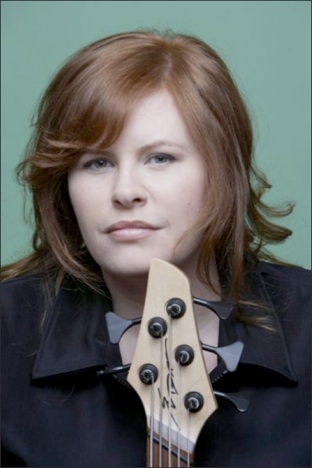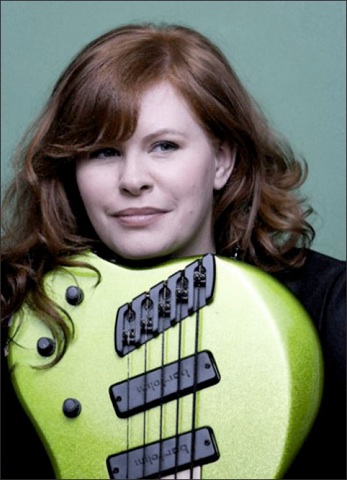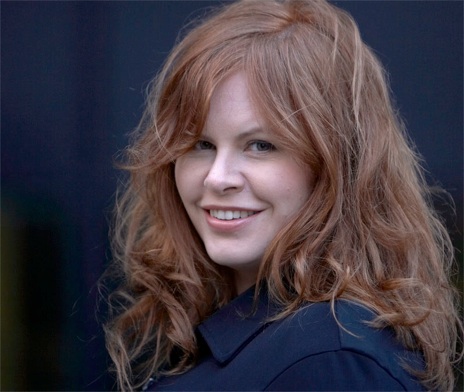Suzie Vinnick
If Aphrodite Could Sing the Blues…
By Richard Cuccaro
Well… she couldn’t. A brief Internet perusal reveals that Aphrodite had no musical skills and actually was a bit of a tramp. But if she could sing, with her seductive skills, it might produce the same effect that Suzie Vinnick does.
It was a blues number, “Save Me for Later” on her album, Me ’n Mabel, that first worked its magic for me. That muscular but silky voice, singing: Save me for later like a child saves chocolate kisses / Save me for later like some flowers for a Mrs. / Like a smoker keeps a cigarette in his pocket / sweethearts keep photos in a locket / They say cookin’ slow brings out the flavor / darlin’ save me for later. Ooooh, Lord, have mercy.
Suzie has become recognized as an accomplished blues singer and guitarist, but she has many ways to seduce a listener. Her sweet assault can strike from every stylistic direction. Me ’n Mabel (2011) shows Suzie’s skills with just her and her Larrivee parlor guitar (christened Mabel as a result of a slip using the word “maple”). Her previous album, Happy Here (2008), is lushly orchestrated and shows Suzie’s ability with a torch song. The album weaves a reverie all the way through. In songs like “My Kind Of Loneliness,” Minnie Riperton-like, she pours heartache into the lyrics: It was bittersweet tonight, seeing you sparkle and glow / On a moonlit sail, across the waters of loneliness…
Need I say it? It should be obvious. I am smitten. North of seven decades on the planet, I am way too old for this sort of thing, damn it.
Beginnings
Suzie Vinnick grew up in the Canadian city of Saskatoon, Saskatchewan. Situated midway between the east and west coasts, I thought that would make her the Canadian equivalent of a “Midwesterner.” She characterized it as more of a prairie environment, so “I’m a ‘prairie girl,’” she said.
Suzie would gravitate toward music as a kid — singing along to an ever-present flow of mainstream radio tunes would make her feel good — but becoming a musician was not a conscious thing.
Her parents had what looked like a cool record collection, but the stereo was broken throughout her childhood. It was a large console that became more of a nice piece of furniture that they stored things in. They never bothered to get a new turntable. With three kids, getting it fixed was not a priority. The chance to absorb whatever was on those records was lost, she recalled.
The sole parental musical influence occurred when her father listened to country music in the car. Suzie didn’t like it and would beg him to change the station. It wasn’t until many years later that she learned to appreciate the genre.
Suzie learned to play guitar because there was one in her own home. “That’s what we could afford. Mom and Dad couldn’t afford a piano,” she told me.
At age 9, she began taking guitar lessons at the Saskatoon Guitar College. (The name Saskatoon might give the impression that it’s a small town, but it’s actually a bustling mid-sized city — population 180,000 then, more than 220,000 now.) That’s when she learned to read music. As a third-grader, she was playing “Stairway to Heaven” and John Denver songs like “Country Roads.” She followed no particular genre, she said, “Anything that I could sing and fake the chords. I just liked the idea of singing songs off the radio.” She continued guitar lessons for two years, but there there were other instruments on her radar.
Suzie was always drawn toward the piano. At around 11 or 12 years old she used to housesit for her aunt and uncle who owned one. Their daughter was taking lessons and had a songbook. Suzie used it to teach herself. “I sat myself down at the piano whenever I could. I taught myself to play a little bit,” she said.
By age 11, she also was playing saxophone in her grade-school concert band and singing in the chorus.
The Emerging Performer
While Suzie continued to explore other instruments, the guitar, in combination with her voice, got her noticed. She said that, “My voice was the first instrument that I got to play around with,” she said, “but I got bolder when I picked up the guitar.” It enabled her to accompany herself and she found a lot of cheerleaders among her teachers.
When she was in fourth grade, her teacher called the principal into her class and had Suzie sing “Country Roads” for him and the class. In fifth grade, the teacher played piano and with Suzie on guitar, they jammed together.
During her time there, the grade school morphed into an arts-oriented school. Her artistic success seemed predestined, she said. Her talent and her innate sense of direction, however, would have a lot to say about that.
One Step at a Time

She remembers at age 11 or 12, taking her allowance — she might have done a tiny bit of baby-sitting to add to her spending money — and going down to the Sears in downtown Saskatoon and plunking down $14 to buy her first album, Supertramp’s Breakfast in America.
When she got a little older, she got her own small record player and would sing and play along with records alone down in the basement, her voice bouncing off of the faux paneling. Sometimes her mother would come down and listen.
High School Whirled
Suzie continued with chorus and concert band in high school. She was also in the wind ensemble, a sax quartet and a jazz combo.
In 1983, she took up bass in high school because she wanted to try something new. She perceived that the other guitar player in the concert band had a better understanding of jazz chords needed to play in the large band repertoire. Since there was no bass in the orchestra, she asked her teacher if she could learn it and take that slot. He readily agreed. She tried the upright bass for a bit, but didn’t care for it and settled with the electric.
I conjectured that playing the bass gave her a better sense of lower notes or the “bottom” in her guitar playing. While she didn’t disagree, she felt, more importantly that it allowed her to “meter-map out how songs move chordally.” It was good for her ear, she added.
From age 13 to15, Suzie had a teacher, John Mair. He accepted and liked certain rock bands such as The Who, but preferred jazz-fusion. She played bass with his band in small-town bar gigs on weekends for about two years. After that, she and John went out as a duo. With John on guitar and Suzie on bass, they played more small-town weekend gigs. They would drive a few hours and do a few sets with a drum machine. She was 16 and still playing sax in the school band and bass in the school jazz combo.
In addition, she had discovered the Saturday jams at a blues bar, Bud’s on Broadway, in Saskatoon. When she wasn’t gigging, she’d join in on bass. Between chorus, various school bands, jams and gigs, she was a very busy girl. Today she wonders where she got the energy.
The Voice
In the beginning, singing along with records was a great way to learn. Her participation in school chorus added to her natural talent. She didn’t really get formal vocal lessons until her late teens. Her voice teacher, Naomi Freisen, was a classical singer but still appreciated the “Broadway belter” style and was able to help her with blues and rock ’n roll. Bottom line, it helped her with mechanics.
Over the years, Suzie has studied with a number of people and works today with a vocal coach when she can because there’s always something to learn. Since she’s working so much more, techniques for preserving her voice are a priority.
College, Briefly
Fresh out of high school, Suzie attended the University of Saskatchewan in Saskatoon for a year. She was in a general arts study program, which included drama and music theory. She wasn’t satisfied and left. She looked into several music programs at colleges in Edmonton and Toronto in Canada and Los Angeles in the U.S., but, nervous about leaving home, stayed in Saskatoon.
The Path of the Blues

One of the blues bands she played in, Back Alley John’s, provided her next step forward. An Ottawa blues guitar player calling himself Tony D. came to Saskatoon to join his girlfriend. Tony played in a style similar to guitar greats Albert King, Freddie King and Stevie Ray Vaughn.
Tony was recruited to play several gigs with Back Alley John. When those gigs were over, Tony and Suzie formed a trio with a drummer. They played for a while until Tony’s relationship ended and he moved back to Ottawa. He kept in touch and asked her to come out for a summer, saying that he had a bunch of gigs lined up. Suzie had no commitments in Saskatoon and enjoyed her time in Ottawa over the summer, so she decided to move there. She stayed for seven years, from 1991 to 1998. She and Tony played together for two years. Suzie did her first recording with Tony, called Dig Deep, in 1992. Suzie’s robust vocals did a strut all over Tony’s snarling guitar licks while her bass provided a relentless throb below. She also provided mandolin backing for one track.
During this time, Suzie wound up doing odd jobs and music on the side. “Tony and I would do a yearly Christmas gig together and some occasional acoustic blues shows as well,” she said. She released her debut solo album Angel in the Sidelines in 1994.
At one of Tony’s shows, her brother’s friend introduced her to the man she would marry about five years later. Her husband got a job in Toronto and they moved there in 1998, but the marriage ended shortly afterward. Suzie stayed, though, and has lived in Toronto ever since.
She made some musical connections, did some gigs, and then got a full-time job working for Marty Simon, a film composer. Marty had extensive knowledge of the music business. He had lived for a number of years in England, was friends with the manager of Foreigner and was in a band called the Sharks with consummate British session/band guitarist Chris Spedding. He told Suzie stories about the music business (some of them hair-raising, no doubt) and she learned a lot from him.
Rick Fines and Suzie
In 1993, a serendipitous crossing of paths in Toronto proved very rewarding. Influential Canadian roots music DJ Chopper McKinnon met accomplished blues player Rick Fines for a beer. He told Rick he shouldn’t be sitting with him when he could go see the bass player at a different bar up the street. Chopper knew that Suzie was playing bass for Back Alley John’s band, which was in Toronto for a gig. Rick went. He saw. He was blown away. Rick asked Suzie if they could play together. They jammed the next day, then started doing shows and went on tour together.
For a 20-something blues player like Suzie, eager to learn, he was very helpful. They’ve worked together off and on for 20 years. In 2006, they co-wrote and released a duet album, Nothing Halfway. Rick has a Dr. John-like voice while Suzie has been compared, at times, to Rickie Lee Jones. On the tracks I sampled, their vocals fit together perfectly.
Side Projects
Suzie also worked in other musical side projects to pay the bills, providing bass and lead and backing vocals. They gave her more learning opportunities and a chance to work with some great people. She joined two female trios with different styles, Vinnick Sheppard Harte and The Marigolds. Vinnick Sheppard Harte was a folk-rock, edgier group and sometimes would hire a drummer. It released two albums, And They All Rolled Over (2000) and My Favorite Shirt (2007). Of the tracks I sampled, I was really impressed with the covers of “Big Yellow Taxi and “Love Hurts,” from My Favorite Shirt. The Marigolds was a more delicate, folkier group with “killer songwriters and singers who could pour out jazzy vocals,” Suzie said. The Marigolds released one self-titled album in 2005.
Betty & the Bobs is a 7-piece variety-show type band which plays quirky music that its members wouldn’t play in other projects. It released one album, Betty & the Bobs in 2006. We’re assuming its cover of “I Enjoy Being A Girl” should be taken ironically, especially when the male singers sing: When I hear a complimentary whistle / that greets my bikini by the sea / I turn and I glower and I bristle / but I’m glad that the whistle’s meant for me.
Suzie still plays with Rick, The Marigolds and Betty & the Bobs. She’ll play festivals with Rick and some gigs with The Marigolds this summer.
Suzie did solo gigs with guitar all through the years with Rick and the other groups, and is now predominately a solo artist. Her solo albums are a treasure.
33 Stars, released in 2002, has a pop feel.while Happy Here, released in 2008, is rootsier. From her Wikipedia page, we learn Happy Here was a nominee for Roots & Traditional Album of the Year – Solo at the 2009 Juno Awards. Her 2011 album, Me ’n Mabel, was a nominee for Blues Album of the Year at the 2012 Juno Awards, and Suzie won the award for Contemporary Singer of the Year at the 2011 Canadian Folk Music Awards
Her most recent album, Live at Bluesville (2012), came about when a radio interview turned into a recording session. Bill Wax, the producer of Sirius/XM B.B. King’s Bluesville station, basically said “Here’s our studio, go in and have some fun!” The result was a typical Suzie tour de force of vocal and guitar. In the CD review section of our December issue I wrote: “She leads off this album with ‘You’ll Be Mine’… Her voice curls around a lyric like a snake on a pole and she walks the bass and treble strings with a commanding strut.”
Her next U.S. appearance will be May 31 at 8 p.m. at The Minstrel Coffeehouse, Morristown Unitarian Fellowship, 21 Normandy Heights Road, Morristown, N.J. Folksinger and Minstrel booking person Mike Agranoff knows real talent when he sees it. So do we. I hope you can join us there.
Website: suzievinnick.com


